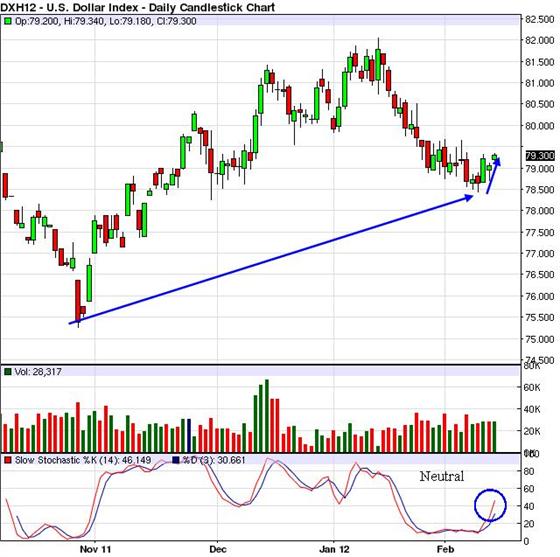Agronomist notes
Hello Reader,
I’m back after a quiet week’s vacation in the Rockies and it was a good one. Sleeping through the night with our three young children is a rarity but mountain air is magical, I tell you. We made sure to be outside as much as possible and it paid off in zzz's.
Mitch and I recently sat down to plan out our equipment purchases and to do list which was great to get out of the way. You can imagine our list with Mr.-I’ve-got-another-great-idea on the loose and well rested: Pattison liquid kit for the drill, OptRx sensors, vacuum planter, ETS strip till machine, SP sprayer upgrade, nitrogen side dress toolbar or sprayer attachment, trucks and hopper bottoms.
I’m headed for Tulare, CA on Tuesday to see the 2012 World Ag Expo and the Bayer CropScience research facility. Should be an enjoyable trip.
In this issue of Beyond Agronomy News, we’ll look at how to build yield in wheat by matching nutrient demand with critical yield building growth stages. Next, I’ll share a great example on the response of magnesium in barley from last week’s article and then some intriguing facts on the use of humates to reduce plant stress and increase yield in conventional farming systems. We’ll finish with fundamental and technical grain market news.
Have a great week.

Building yield in wheat
2012 High Yield Trials
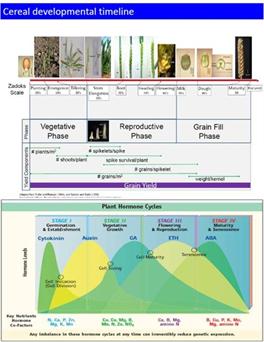 I’ve started to work on the agronomy package designed for our high yield wheat trials in 2012. We’re aiming for 120 bu/ac HRS wheat and 150 bu/ac CPS. I know 120 bu/ac is possible because we hit it with CDC Go near Three Hills back in 2010 after 16 inches of rain, 7,000 gal/ac of liquid manure, and 160 lbs/ac of seed. Replicating it will be the difficult part.
I’ve started to work on the agronomy package designed for our high yield wheat trials in 2012. We’re aiming for 120 bu/ac HRS wheat and 150 bu/ac CPS. I know 120 bu/ac is possible because we hit it with CDC Go near Three Hills back in 2010 after 16 inches of rain, 7,000 gal/ac of liquid manure, and 160 lbs/ac of seed. Replicating it will be the difficult part.
To build yield in wheat it’s very important to understand the growth stages where yield is derived and then work backwards to outline which nutrients are required the most at specific growth stages. This allows us to target the right nutrients at the right time with the trick being the right product with the right rate given your soil, management and climate.
Dr. Dave Hooker from the University of Guelph provided me with this excellent slide showing the growth stages of wheat where we can build yield. I’ve combined this cereal growth stage and yield building chart with the key nutrients that drive yield at certain growth stages. Combining these charts outlines the critical yield building stages with the key nutrient drivers to help you plan a nutrient strategy.
The best way to view the charts is here on our website.
The cereal development timeline chart outlines four key growth stages where yield is built:
1. Tillering: number of heads
2. Stem elongation: size of heads
3. Flowering: grains per head
4. Grain fill: weight of kernels
The Plant Hormone Cycles chart outlines the key nutrients that drive yield during each yield building growth stage.
1. Tillering: Ca, Cu, Mg, B, Mn, Zn, N03
2. Stem elongation: Ca, B, Mg, amine N
3. Flowering: Ca, B, Mg, amine N
4. Grain fill: B, Cu, P, K, Mo, Mg, amine N
Next, you need to know how much of each nutrient is required so you can relate it back to your soil test levels and what you may need to apply. Granted, soil and tissue tests don’t tell the whole story so use your creativity and judgement to design your nutrient strategy, especially with your trials.
Nutrient uptake of spring wheat (lbs/bu):
2.3N 0.007Zn
0.8P 0.004Mn
2K 0.001Cu
0.25S 0.003B
0.19Ca 0.02Fe
0.17Mg
To determine nutrient uptake demand, mulitply your yield target by the values above. Using the trial target yield of 120 bu/ac lets look at a quick example.
2.3 N x 120 bu/ac target = 276 lbs/ac
0.8 P x 120 bu/ac target = 96 lbs/ac
0.004 Mn x 120 bu/ac target = 0.48 lbs/ac
0.001 Cu x 120 bu/ac target = 0.12 lbs/ac
0.17 Mg x 120 bu/ac target = 20 lbs/ac
0.19 Ca x 120 bu/ac target = 23 lbs/ac
You can see in this example how massive the uptake requirements are of N and P when you’re targeting big yields. They will be the main drivers but just as important with high yield production are the micronutrients. The trick is to discover what nutrients your soil can provide, what you need to supplement with and at what rate. To give you some additional fodder, I’ve listed some of the key nutrients that match our critical growth stages and the approximate nutirent rates you should look at.
Typical foliar rates:
CaN03: 11% at 1 lb/ac
Mg: 36% at 2 lbs/ac
Cu: 5% at 0.126 lbs/ac
Zn: 9% at 0.26 lbs/ac
B: 10% at 0.29 lbs/ac
Mo: 0.02% at 0.05 lbs/ac
Armed with this information, you now know the four critical growth stages to building wheat yield, the nutrients that drive yield at each growth stage, the level of nutrients required to hit your yield target and some of the micronutrient application rates I’m using as a guideline to fine tune the 2012 high yield trials. There’s no doubt we can hit 120 bu/ac wheat and 150 bu/ac CPS. The trick is how we match the nutrition program to the meet the requirements at specific growth stages. Make the two click and that’s how world records are broken. SL
Image sources: D. Hooker, U of Guelph, Stoller USA
Magneisum trials in 2012
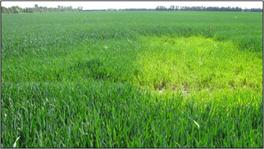 Reader comments
Reader comments
I’ve had some great feedback from Beyond Agronomy News readers from across the globe on the results of magnesium. Chris Dennison from New Zealand sent a picture of the results he had applying foliar magnesium sulphate (MgS04) at 7 lbs/ac at tillering in barley. The picture shows the dramatic results from what would be a 3x rate of MgS04 on a lime dump area from 7 years ago. The pH is only 6 in this area but the calcium levels are through the roof from the lime. The results are remarkable and show the effects high calcium can have on magnesium uptake and how responsive barley is to foliar magnesium. Hmm, I wonder if we have high calcium soils? That was a retorical question.
To give you an idea about rates and timing, I’ve listed the details below to help you plan your trials for 2012.
Products: ATP Nutrition, Omex
Rate: Apply 2 lbs/ac of 36% MgS04
Mixing: Adding MgS04 wettable powder first into the spray tank as it will buffer the solution down to about a pH of 5, much like ammonium sulphate and is compatible with most herbicides and fungicides.
Timing: Late tillering with herbicide (GS 30-31) and again at fungicide timing (GS 39-45)
Cost: Approximately $0.64 lb or $1.28 ac at 2 lbs/ac
When you’re trying to decide whether or not to run magnesium trials, remember that deficiencies can occur on high pH, high manganese, high calcium, high potassium and even high magnesium soils. I’d like to trial it on a number of client farms this year. SL
Photo source: Chris Dennison, NZ
Humates: an organic product for conventional farming
I had a conversation a couple years ago with an organic orchard grower from Western Australia about how he used humates in his agronomy program. Being intrigued, I decided to do some research on what humates are exactly, the benefits of using them, and how they fit into our production system. Though well known to organic farmers, the only conventional farmer I've heard of who uses humates is Kip Cullers. Kip Cullers is the current world record holder for soybean yield at 160 bu/ac (14.5 T/ha) and humates are part of his high yield program. He is also the national record holder for irrigated corn in the US at 335 bu/ac (22.5T/ha).
So what are humates? Humates are a combination of humic, ulmic and fulvic acids. Humic acids are found in humus, and humus is formed by the decomposition of vegetable and animal matter. Humates are mined from the soil from old decomposed vegetative and animal deposits. Humates (humic, ulmic and fulvic) are essential to plants in three basic ways:
1. Humic acid enables plants to extract nutrients from the soil,
2. Ulmic acid stimulates and increases root growth; and
3. Fulvic acid helps plants overcome stress.
The benefits of using humates are many. Here's a condensed version of the research I've found. I've attached relevant research findings to support the claims.
• Reduces drought stress and improves yield stability. When wheat plants were subjected to drought stress at head development stage, grain yield by untreated plants was depressed by 30% compared to the irrigated control. However, fulvic acid treated plants suffered only a 3% yield loss compared to the irrigated control. Xudan (1986)
• Reduces heat and salt stress. Fulvic acid was sprayed on plants just before head development, and allowed to grow to maturity over time when hot, dry winds are prevalent. It was found that grain yield increased by 7% to 18% over the untreated controls. Xudan (1986)
• Increases soil water holding capacity. Humates can hold up to 20 times their weight in water. By enhancing the soil's ability to retain water, humate usage can reduce the need for irrigation. This can be especially helpful with sandy soils, and contributes a large measure of drought resistance to crops.
• Stimulates root growth. Lee and Bartlett (1976) studied stimulation of corn seedling growth in low organic matter soil with 8 mg/Kg Na-humate and found increases in seedling growth of 30 to 50%.
• Provides stimulus for beneficial soil microorganisms. Vallini et al. (1997) investigated the effect of humic acids on activity and growth of Nitrosomonas europaea and Nitrobacter agilis. They found that both types of humic acids increased either NH4+ or NO2-oxidation and cell growth of nitrifying bacteria.
• Increases nutrient uptake. Humic acids were added to an alkaline soil with phosphate fertilizer to wheat grown in field trials. It was observed that phosphate uptake and yield were both increased by 25%. Wang et al. (1995)
Farmers have long been inundated with magic dust products that claim to do everything from increase root growth to curing dandruff. Right now, I can hear sceptics saying "Yeah right, Steve, you're pushing snake oil." Hear me out when I say there's some merit in researching humates further and seeing what fit they could have in our production system. I see their biggest potential coming from increased phosphorus efficiency, improved nutrient mineralization and the ability to reduce stresses from heat, drought and salts like the research states.
Today, our phosphorus uptake efficiency might be 15% to 30% in the year of application. You could potentially see tremendous yield benefits if you could boost that efficiency to 45% or 55% in the year of application. This product would be a great fit for those with high pH soils and low phophorus levels below 20 lbs/ac. The additional benefits of reducing heat, drought, salt, insect and disease stresses are a bonus. I plan to trial humates at the farm this year and I'll be looking for some of my clients to do so as well. Black Earth Humates Ltd. in Edmonton sells humate products. SL
Source, source
Market News
Technicals
Canola Nov12: The long term trend is down and the short term trend is up.
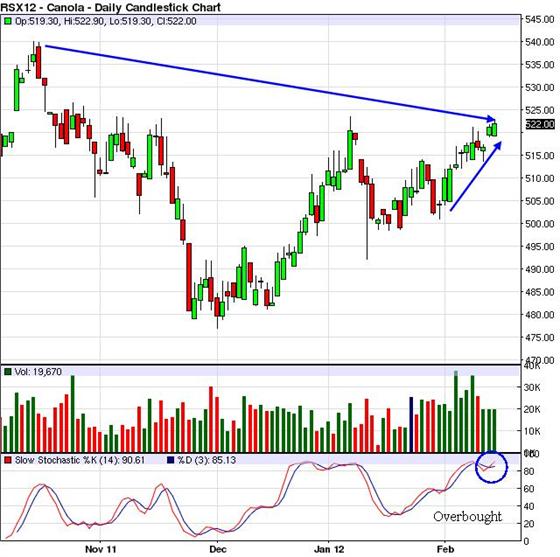
Wheat Dec12: The long and short term trend is down.
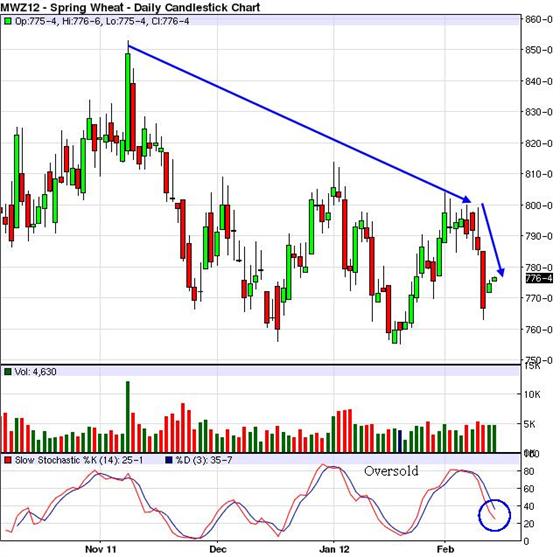
Corn Dec 12: The long and short term trend is down.

Soybeans Nov12: The long term trend is flat and the short term trend is up.
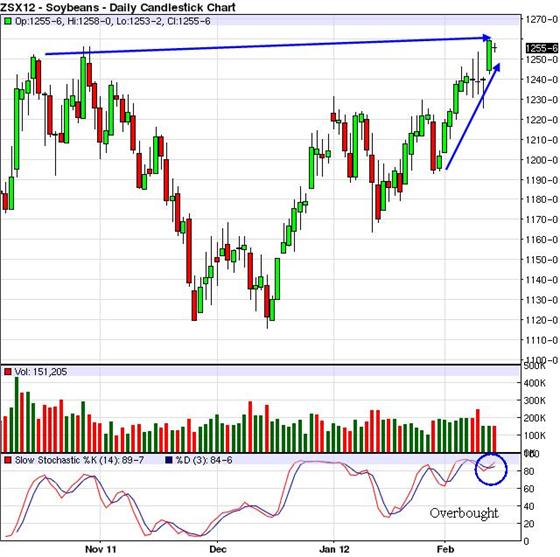
CDN$ Feb12: The long term trend is flat while the short term trend is down.
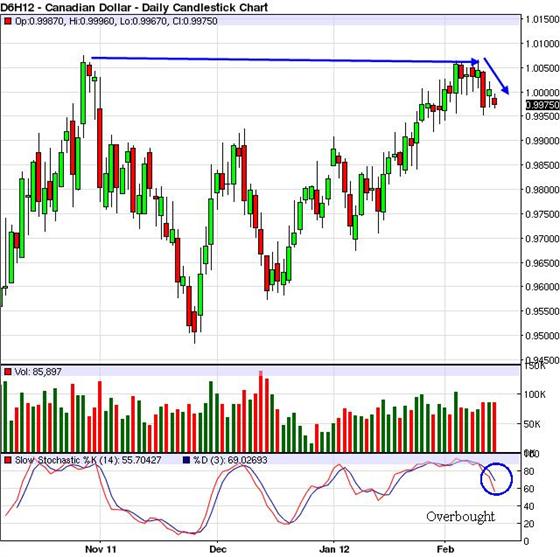
USD Feb12: The long and short term trend is up.
